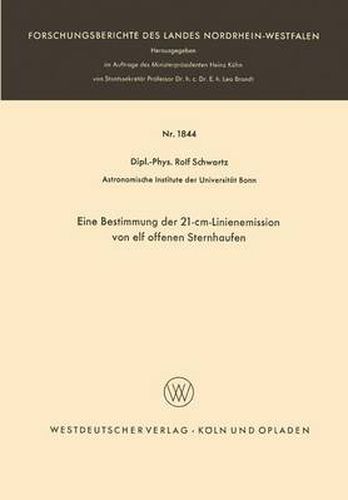Readings Newsletter
Become a Readings Member to make your shopping experience even easier.
Sign in or sign up for free!
You’re not far away from qualifying for FREE standard shipping within Australia
You’ve qualified for FREE standard shipping within Australia
The cart is loading…






This title is printed to order. This book may have been self-published. If so, we cannot guarantee the quality of the content. In the main most books will have gone through the editing process however some may not. We therefore suggest that you be aware of this before ordering this book. If in doubt check either the author or publisher’s details as we are unable to accept any returns unless they are faulty. Please contact us if you have any questions.
21-cm-line profiles of eleven open clusters and their immediate surroundings have been obtained showing line-emission of the clusters as well as that of the general galactic field. The expected profiles for the latter have been obtained in two, partially independent, ways, and substracted from the cluster profiles. The difference-profiles suggest in several cases the presence of interstellar neutral hydrogen gas within the cluster region. In a few cases the gas seems to expand 7 with a velocity of about 7 km/sec. All clusters with an age of 2. 5 . 10 years or 8 less contain interstellar hydrogen gas while no clusters older than 1. 5 . 10 years have detectable amounts of gas. The gas is found in a region which is, in the average, 3 to 4 times the apparent optical diameter. Einleitung Ein offener Sternhaufen hebt sich als eine mehr oder minder dichte Gruppe von einigen zehn bis einigen tausend Sternen vom allgemeinen Sternfeld abo Die Untersuchung offener Sternhaufen ist flir Probleme der Sternentwicklung bedeutsam. Flir Strukturanalysen der MilchstraBe stellen - vor allem die jlin- geren - Sternhaufen besonders geeignete Objekte dar. In dieser Arbeit wird der Versuch unternommen, die 21-cm-Linienemission des neutralen atomaren Wasser- stoffs (HI) zu messen. Es wurden elf offene Ste: ‘nhaufen nach folgenden Gesichts- punkten ausgewahlt: a) Es solI ein moglichst weiter Bereich des Haufenalters (frlihester Spektraltyp) iiberdeckt werden. b) Die optischen Winkeldurchmesser der Sternhaufen sollen kleiner als die MeB- keule von 33’ des Teleskops sein.
$9.00 standard shipping within Australia
FREE standard shipping within Australia for orders over $100.00
Express & International shipping calculated at checkout
This title is printed to order. This book may have been self-published. If so, we cannot guarantee the quality of the content. In the main most books will have gone through the editing process however some may not. We therefore suggest that you be aware of this before ordering this book. If in doubt check either the author or publisher’s details as we are unable to accept any returns unless they are faulty. Please contact us if you have any questions.
21-cm-line profiles of eleven open clusters and their immediate surroundings have been obtained showing line-emission of the clusters as well as that of the general galactic field. The expected profiles for the latter have been obtained in two, partially independent, ways, and substracted from the cluster profiles. The difference-profiles suggest in several cases the presence of interstellar neutral hydrogen gas within the cluster region. In a few cases the gas seems to expand 7 with a velocity of about 7 km/sec. All clusters with an age of 2. 5 . 10 years or 8 less contain interstellar hydrogen gas while no clusters older than 1. 5 . 10 years have detectable amounts of gas. The gas is found in a region which is, in the average, 3 to 4 times the apparent optical diameter. Einleitung Ein offener Sternhaufen hebt sich als eine mehr oder minder dichte Gruppe von einigen zehn bis einigen tausend Sternen vom allgemeinen Sternfeld abo Die Untersuchung offener Sternhaufen ist flir Probleme der Sternentwicklung bedeutsam. Flir Strukturanalysen der MilchstraBe stellen - vor allem die jlin- geren - Sternhaufen besonders geeignete Objekte dar. In dieser Arbeit wird der Versuch unternommen, die 21-cm-Linienemission des neutralen atomaren Wasser- stoffs (HI) zu messen. Es wurden elf offene Ste: ‘nhaufen nach folgenden Gesichts- punkten ausgewahlt: a) Es solI ein moglichst weiter Bereich des Haufenalters (frlihester Spektraltyp) iiberdeckt werden. b) Die optischen Winkeldurchmesser der Sternhaufen sollen kleiner als die MeB- keule von 33’ des Teleskops sein.